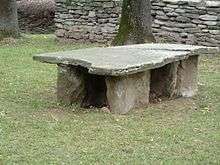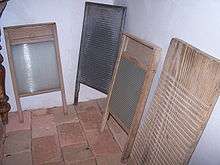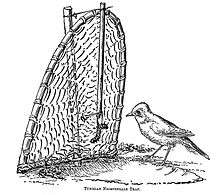Stone slab

A stone slab is a big stone, flat and of little thickness, that are generally used for paving floors, for covering walls or as headstones.[1]
Other definitions refine the meaning a bit more:
- Flat big stone and of little thickness.
- Flat stone, relatively thin, of rectangular form or almost rectangular.
In dolmens
Most dolmen constructions were built using stone slabs of big dimensions. Their architecture often includes a corridor of access that can be constructed using stone slabs or dry stones. The burial chamber, with variable shapes (e.g. rectangular, polygonal, oval, circular) can also be preceded by an anteroom. In some dolmens, the entrance has a door cut into one or more vertical stone slabs.[2][3]
In construction

The main applications of the slabs as material of construction are for pavings and in the construction of roofs. They can be employed for other uses, among them:
- Balconies formed from a slab
- Dry stone constructions of: walls, caves, rooms.
- The base of some fireplaces are build with stone slabs (a big one or some smaller together).
- In religious altars, the altar stone can be a stone slab, more or less elaborated or in its natural state.
- In rustic tables.
- Slate slabs used for roofs.[4][5][6]
In gastronomy
One system of cooking is cooking "to the slab".[7] Similar to the systems of "to the iron" or "grilled", in the procedure to bake to the slab the foods (e.g. meat, fish, vegetables) are put on a slab heated on a fire with oil, butter or lard and other garnishings.[8]
Grave slabs

From prehistoric times there have been examples of graves covered with a stone slab, in its natural state or carved. This use of slabs as tombstone has extended the concept of natural slab to the tombstone variant: flat, thin and polished. One is example is the slab in the tomb of King Pere el Gran of Aragon, which weighs 900 kg.[11]
The tombstones usually have some inscriptions. The information on the stone slab traditionally includes the name of the deceased and his date of birth and death. The inscriptions are generally in the frontal side of the stone slab but also in some cases in the verso and around the edges of the slab, some families request to write an inscription in the unseen part of the stone slab (oriented to the ground). Apart from the name, some slabs also have epitaphs in praise of the deceased or citations of religious texts, such as "Requiescat in pace".[12]
Washboards

Washing clothes is a basic need in civilised societies and, in general, in all the parts of the world. In primitive periods—before running water, washing machines and detergents—it was necessary to go to wash the clothes to the river bank or in a laundry room.
Clothes were washed manually, by rubbing and sometimes striking them against a hard surface with soap. The aim was to do penetrate the mix of water and soap between the fibres of the fabric to pull-out the dirt. The slabs to wash the clothes were slabs of natural stone chosen to present a fine and relatively flat surface. The small rounded irregularities could help of friction in the washing process.[13][14]
- In some cases "artificial slabs" were made especially, in which the friction surface was wood, although the apparatus was still called "washing slab".
- There were also "artificial slabs" made with an undulated steel sheet. (These type of washboards have been used as percussion instruments in jazz and blues bands).)[15]
- The wash to the stone of cowboys trousers and similar clothes is a stone washing process that uses the friction of some parts of the clothes against a coarse stone (or similar). The aim is to achieve a change of appearance of the clothes, imitating natural wear.
As hunting traps

Hunting with slabs is a system of hunting by means of a slab-trap. The fundamental part of the device is a slab. Preparing this trap was a delicate task.[16][17][10]
- Preparation of the trap: A slab of suitable dimensions is held in a raised position forming an appropriate angle with the horizontal. The slab, in unstable position, held in place by means of a few twigs or branches in a particular state, a state that can be called "ready to be triggered" (or at the trigger point). Once the slab is ready, one needs to put a suitable bait to attract the animal that wants to capture.
- When the animal (e.g. bird, rabbit) tries to eat the bait, the slab falls on top of the animal and gets trapped (or crushed).
The term "slab" in toponyms
From the term slab and its derivatives, there are many toponyms among them.
See also
References
- ↑ Thomas Dyche; William Pardon (1740). A New General English Dictionary; Peculiarly Calculated for the Use and Improvement of Such as are Unacquainted with the Learned Languages... and Now Finishʼd by William Pardon. Richard Ware, at the Bible and Sun in Warwick-Lane, Amen-Corner. pp. 772–.
- 1 2 Francesc Antillach Comabella; Antònia Ortiz Pedrosa (2003). Caminades per la Noguera. Cossetània Edicions. pp. 60–. ISBN 978-84-96035-21-8.
- ↑ Anna Borbonet; Jordi Sanglas i Puigferrer (1999). Tavertet, el seu terme i els seus noms de lloc. L'Abadia de Montserrat. pp. 100–. ISBN 978-84-8415-110-4.
- ↑ Pablo Collado Trabanco; David Nuño Peña (2006). Supervisión de ejecución de acabados, revestimientos y cubiertas. Lex Nova. pp. 125–. ISBN 978-84-7557-180-5.
- ↑ Estructuras metálicas. Reverte. 1980. pp. 169–. ISBN 978-84-7146-199-5.
- ↑ Juan José Trujillo Cebrián (10 December 2013). Ejecución de faldones en cubiertas. EOCB0208. IC Editorial. pp. 208–. ISBN 978-84-15994-96-1.
- ↑ www.esimple.it, © Esimple srl -. "Tortello alla lastra".
- ↑ Primitive Cooking Stuffed Bannock On A Stone
- ↑ La cuina catalana segons Jaume Fàbrega
- 1 2 Josep Gironès Descarrega (2005). La cuina més senzilla d'una dona del terròs. Cossetània Edicions. pp. 43–. ISBN 978-84-9791-121-4.
- ↑ Llosa de la tomba de Pere el Gran Archived 2016-10-27 at the Wayback Machine.
- ↑ Fergus Wessell. "Headstone Gallery". Archived from the original on 2013-07-07. Retrieved 2013-09-05.
- ↑ Josep Massot i Muntaner (10 November 2010). Obra del Cançoner Popular de Catalunya. Volum XX.: Missions de recerca. L'Abadia de Montserrat. pp. 219–. ISBN 978-84-9883-337-9.
- ↑ "QUI TÉ ROBA PER RENTAR?". Icaria Editorial. 16 July 2008 – via Google Books.
- ↑ "History of washboards, invention of zinc scrub boards & other rubbing boards".
- ↑ Moisés D. Boza (March 2012). El trampeo y demás artes de caza tradicionales en la península ibérica. Editorial HISPANO EUROPEA. pp. 4–. ISBN 978-84-255-1446-3.
- ↑ Diccionari catalá-castellá-llatí-frances-italiá, 1. En la imprèmpta de Joseph Torner. 1839. pp. 147–.
External links
![]()